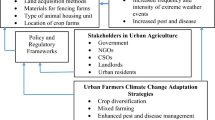Abstract
This paper presents an approach for GIS integrating local participatory land management information used for regional planning, and contributing to a bottom-up approach to land use planning. In participatory planning, the integration between local and regional levels should facilitate the communication and co-operation among the parties at both levels, for an efficient use of available resources. For coherently linking these two levels it is necessary to transform the data produced at one level, in order to be usable by the other. This transformation consists of a spatial procedure, which allows scaling-up the local participatory rural appraisal (PRA) information for regional purposes and scaling down the regional information for local use, using a GIS. Such an integration procedure is presented and discussed using data from a case study in south-western Burkina Faso.
Similar content being viewed by others
References
Bayer W. and Waters-Bayer A., 1994: Planning with pastoralists: PRA and more: a review of methods focused on Africa. Deutsche Gesellschaft fur Technische Zusammenarbeit (GTZ), Eschborn.
Boudet G., 1991: Manuels et précis d'élevage: 4. manuel sur les pâturages tropicaux et les cultures fourragères. IEMVT, La Documentation Française.
Chambers R., 1994: Participatory Rural Appraisal (PRA): Analysis of experience. World Development 2(9): 1253–;1268.
Checkland P, and Scholes J., 1990: Soft Systems Methodology in Action. John Wiley & Sons, Chichester.
Davis G.B. and Olson M.H., 1985: Management information systems: conceptual foundations, structure, and development. McGraw-Hill (McGraw-Hill series in Management Information Systems), New York.
Dent D., 1997: Policy for the management of natural resources. Land-Chatham. 1(1): 3–;27.
Driessen P.M. and Konijn N.T., 1992: Land-use systems analysis. Wageningen Agricultural University, Dep. of Soil and Geology. Malang, INRES.
Dugué P., 1989: Possibilités et limites de l'intensification des systèmes de cultures vivriers en zone Soudano-Sahelienne: Le cas du yatenga (Burkina Faso). Département Systèmes Agraires du CIRAD, Montpellier.
FAO (ed), 1995: Planning for a sustainable use of land resources. Towards a new approach. FAO, Rome.
Fresco L., Huizing H.G.J., Van Keulen H., Luning H.A., 1990: Land evaluation and farming systems analysis for land use planning: FAO guidelines. Working document, Rome.
Gottlieb P. and Reilly J.A., 1994: Simulation model for state growth management planning and evaluation: the New Jersey case. Comp. Environ. Urban Syst. 18(1): 43–;53.
Groten S.M.E., 1997: Air Photos as means of communication in land Management. Agricult. Rural Develop. 4(1): 11–;14.
Grenier L., 1998: Working with indigenous knowledge: a guide for researchers. IDRC, Ottawa.
Loader R. and Amartya L., 1999: Participatory Rural Appraisal: Extending the research method base. Agricult. Syst. 62: 73–;85.
Luning H.A., 1986: Survey comes of age?: Inaugural address upon his official acceptance of the office op professor of survey integration for development at the International Institute for Aerospace Survey and earth Sciences (ITC), 9 January 1986, Enschede.
Maatman A., 2000: Si le fleuve se tord, que le crocodile se torde: Une analyse des systèmes agraires de la région Nord-Ouest du Burkina Faso a l'aide des modèles de programmation mathématiques. Centre for Development Studies, University of Groningen, Groningen.
Mohamed A.A., 1999: An integrated agro-economic and agro-ecological framework for land use planning and policy analysis: farm type land units, PhD Thesis Wageningen Agricultural University, Wageningen.
Molenaar M., 1993: Objects hierarchies and uncertainty in GIS or why the standardisation is so difficult. Geo-Inform. Syst. 6(3).
Molenaar M., 1998: An introduction to the theory of spatial object modelling for GIS. Taylor & Francis, London.
Nurse M.C., Singh H.B., Paudyal B.R., Bonjan S. and Riley J. 1993: Beat-level planning: Development of a management information system for community forestry. Second National Community Forestry Workshop. Nepal, Banko-Janakari 4(1): 91–;95.
O'looney J., 2000: Beyond maps: GIS and decision making in local government. Environmental Systems Research Institute (ESRI), Redlands.
Rabbinge R. and van Ittersum M. K., 1994: Tensions between aggregation levels. In: Fresco et al. (eds), The future of the land: mobilising and integrating knowledge for land use options. International interdisciplinary conference, Wageningen. Wiley & Sons, Chichester.
Ramm J.F., 1992: A planning and training approach for local development in Madang Province, Papua New Guinea UNCRD-Working-Paper, No. 92(1).
Scoones I. and Thompson J., 1994: Knowledge, power and agriculture: towards a theoretical understanding. In: Scoones I. and Thompson J. (eds), Beyond farmer first: rural people's Knowledge, agricultural research and extension practice. Intermediate Technology, London.
Sedogo L.G. and Groten S.M.E., 2000: Definition of land management units for GIS support to participatory planning: A case study on participatory land management in Burkina Faso. In: Cowie W. (eds), Special Issue: Participatory Development Vol. XXI Canadian Journal of Development Studies, University of Ottawa, pp. 523–;542.
Tang A.Y., Adams T.M., Usery E.L., 1996: A spatial data model design for feature-based geographical information systems Intern. J. Geogr. Inform. Syst. 10(5): 643–;659.
UNCED, 1992: Earth summit: convention on biological diversity. In: U.N. (eds), United Nations Conference on Environment and Development UNCED, Rio de Janeiro, Brazil. United Nations, New York.
United Nations, 1996: Manual on GIS for planners and decision makers. Economic and Social Commission for Asia and the Pacific, New York.
Van den Hoek A.I., 1992: Planning as a Learning process: a strategy for planning land use programmes at local level with special reference to the uplands of Java. PhD Thesis. Wageningen Agricultural University, Wageningen.
Van Duivenbooden N., 1997: Land-use system analysis, a multi-scale methodology to explore options for development of sustainable agricultural production system. International conference on Geo-Information for sustainable land management. 17–;21 August, Enschede, The Netherlands.
Walker M. and Sarkar A.A., 1996: The development of a national agricultural extension policy in Bangladesh. Europ. J. Agricult. Educ. Extension. 3(2): 85–;95.
Yue-Hong Chou, 1997: Exploring spatial analysis in geographic information systems. OnWord Press, Santa Fe.
Author information
Authors and Affiliations
Rights and permissions
About this article
Cite this article
Sedogo, L.G., Groten, S.M. Integration of local participatory and regional planning: A GIS data aggregation procedure. GeoJournal 56, 69–82 (2002). https://doi.org/10.1023/A:1022438331943
Issue Date:
DOI: https://doi.org/10.1023/A:1022438331943




